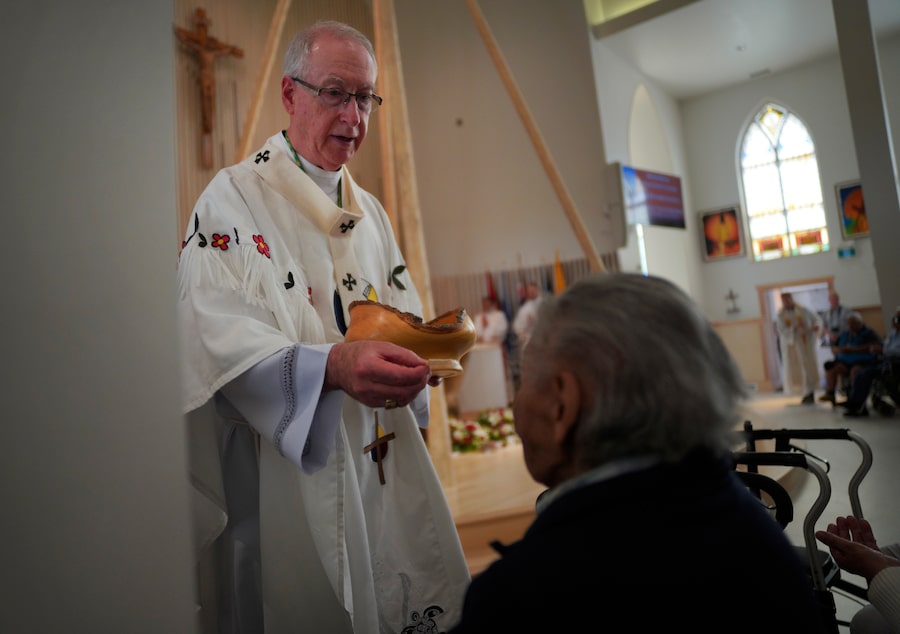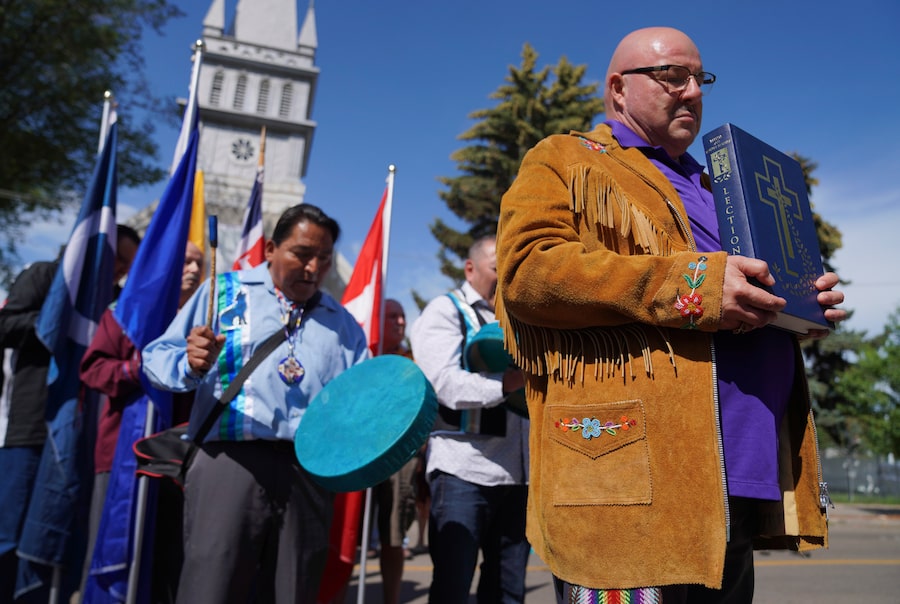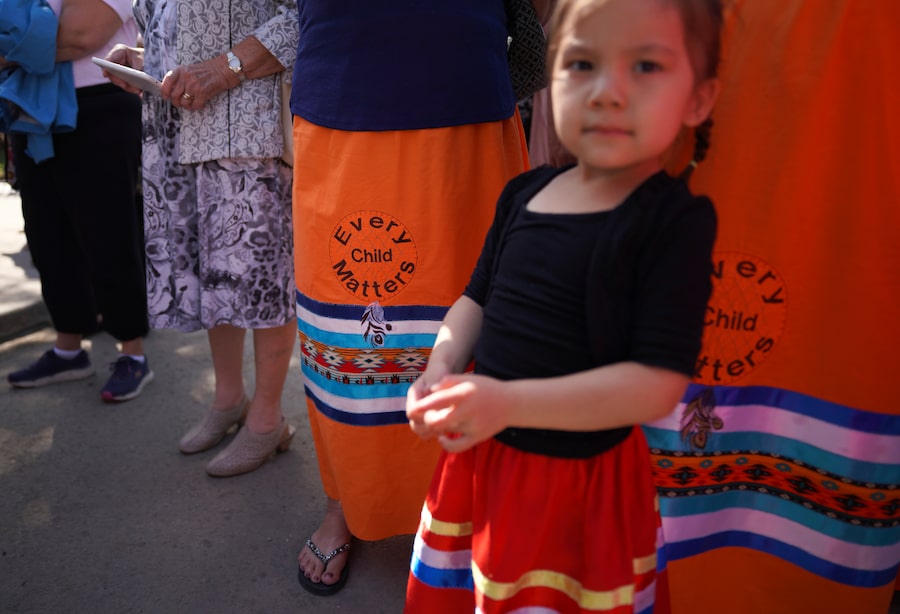Fernie Marty uses an eagle’s wing to tend to his smouldering blend of horse sage, buffalo sage, sweet pine and cedar at church. He gently waves the wing, its feathers coloured coffee and cream, through the wisps of smoke and over the parishioners queued to smudge.
Mr. Marty wears black cowboy boots, buckled blue jeans and a crucifix. He visits with his fellow churchgoers in English and Cree, and when folks approach he taps their heads and backs with the eagle’s wing. Mr. Marty is an elder at Edmonton’s Sacred Heart Church of the First Peoples, which blends Indigenous symbols, ceremony and spirituality with Catholic liturgy. High-flying eagles represent freedom and are sacred in some Indigenous cultures.
“We believe he carries our prayers to the Creator,” says Mr. Marty, who is part of the Papaschase First Nation and originally from Cold Lake, Alta. “An eagle will fly above the storm.”
On Monday afternoon, Pope Francis will gather with Mr. Marty and about 150 other Sacred Heart parishioners at their newly renovated church, located in Edmonton’s inner city McCauley neighbourhood, as part of the Vatican’s reconciliation tour in Canada. The visit will follow the Pope’s time in Maskwacis, a First Nations community about 100 kilometres south of Edmonton, where he is expected to build on his April apology for abuse Catholics perpetrated against Indigenous peoples in the country’s residential schools.
Edmonton Catholic church with Indigenous traditions prepares for Pope Francis’s visit
Mr. Marty, who picks medicines for his blend in Alberta and British Columbia, will smudge parishioners in Sacred Heart before the Pope arrives, but has been told the Holy Father will take a pass because one of his lungs was partially removed decades ago owing to pulmonary illness. “That’s okay. It is just an honour and a blessing to shake this man’s hand,” says Mr. Marty, who is 73.
The Vatican bills Pope Francis’s stop at Sacred Heart as an “encounter,” which, in the parlance of the church, indicates a deeper, more intimate connection than a formal meeting or visit. It is anchored in outpouring and listening, a theme dear to Pope Francis.
Sacred Heart sits on 96th Street, also known as Church Street, where roughly a dozen churches are clustered in a working-class neighbourhood. The church, whose red brick exterior reflects French Gothic Revival-style architecture, opened Christmas Day, 1913. Two years ago, a fire caused by smudging materials damaged the interior; Richard Smith, the Archbishop of Edmonton, rededicated the church on July 17 as the congregation returned for the first time since the blaze.
Church officials expect the renovation and restoration effort, which revealed asbestos in the plaster, to cost $6-million. The work is an opportunity for Sacred Heart to give further prominence to First Nations, Métis and Inuit symbols. Now, for example, four tipi poles meet high above the altar, which is made out of a root ball, putting an Indigenous twist on John 1:14 (”The Word became flesh and made his dwelling among us”). Ron Martineau, the parish’s financial secretary, says the church’s new tabernacle will similarly take the form of a tipi.
The newly-renovated Sacred Heart Church of the First Peoples is shown in Edmonton on Monday, July 18, 2022. The building has been under renovation after a fire, and they have hurried to be ready for Pope Francis’ visit at the end of the month. THE CANADIAN PRESS/Amber BrackenAMBER BRACKEN/The Canadian Press
Fernie Marty, left, and Father Mark Blom stand by the the newly-renovated church's altar, which is made from the roots of a tree, in relation to a metaphor for Indigenous people as a tree buffeted by storms.AMBER BRACKEN/The Canadian Press
In the 1980s, a small group of people formed the Native Pastoral Centre in Edmonton. Participants gathered in a warehouse, as well as a gym across from Sacred Heart – traditionally a home for immigrant communities. In October 1991, Joseph MacNeil, then the archbishop of Edmonton, designated the church as the national parish for people who are First Nations, Métis or Inuit, and it is now the official home for Indigenous Catholics in Canada.
While the church is not exclusively Indigenous – it has a notable Eritrean congregation, for example – symbols such as eagles, medicine wheels, and tipis send a crucial message, says Father Susai Jesu, who is among its current leaders.
“We don’t want to say this is an Indigenous church. It should be seen as an Indigenous church,” says the pastor, who is originally from India but speaks Cree.
Marlene Poitras, the head of Sacred Heart’s choir and former Assembly of First Nations regional chief for Alberta, says the Pope will witness different aspects of Indigenous culture, including fiddling, drumming and singing, during the hour-long encounter.
Ms. Poitras, a member of Mikisew Cree First Nation, attended day school and says her parents were among the 150,000 Indigenous children estimated to have attended residential schools in Canada. Her father, she says, would not talk about his experience and died in 2017 without resolution. Ms. Poitras says her mom only recently started to talk about her time in residential school.
While Sacred Heart parishioners are excited for the Pope’s trip, Ms. Poitras recognizes some Indigenous people are skeptical – or even resentful – of the Vatican’s outreach. Generations of Indigenous children in Canada and the United States were forced to attend residential schools, where many suffered physical, sexual and emotional abuse, leading to intergenerational trauma.
“I’m hoping that those people that had those awful experiences will find some closure and move toward healing,” she says.
The papal visit was spurred in part by a number of Indigenous communities discovering unmarked grave sites near former residential schools last summer, through the use of ground-penetrating radar and other survey technologies.
The Indian Residential Schools Settlement Agreement recognizes 139 residential institutions in Canada, with 26 of those in Alberta. Catholic organizations ran roughly 60 per cent of the residential schools for Indigenous children in Canada, and the last one closed in 1997. The National Centre for Truth and Reconciliation counts 4,000 children who died at or after attending the institutions, although the chair of the Truth and Reconciliation Commission said between 15,000 and 25,000 children may have perished at the facilities.
Mr. Marty, the elder at Sacred Heart, is not yet sure what he will say to the Pope, but he is pleased the Catholic leader is coming to Canada.
“He is bringing the apology to the people – the First Nations,” Mr. Marty says. “The atrocities happened here, in this country.”
Our Morning Update and Evening Update newsletters are written by Globe editors, giving you a concise summary of the day’s most important headlines. Sign up today.









 Carrie Tait
Carrie Tait